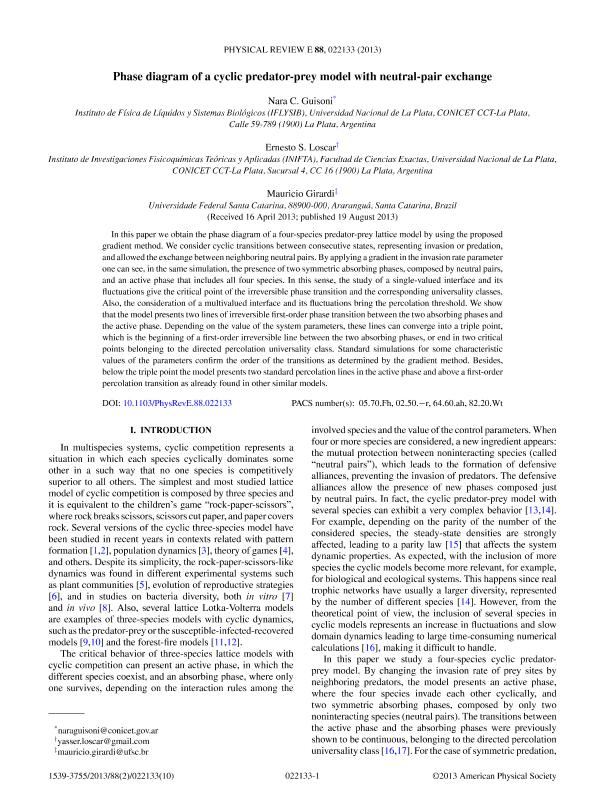Mostrar el registro sencillo del ítem
dc.contributor.author
Guisoni, Nara Cristina

dc.contributor.author
Loscar, Ernesto Selim

dc.contributor.author
Girardi, Mauricio
dc.date.available
2016-09-06T20:21:37Z
dc.date.issued
2013-08
dc.identifier.citation
Guisoni, Nara Cristina; Loscar, Ernesto Selim; Girardi, Mauricio; Phase diagram of a cyclic predator-prey model with neutral-pairs exchange; American Physical Society; Physical Review E: Statistical Physics, Plasmas, Fluids And Related Interdisciplinary Topics; 88; 8-2013; 221331-2213310
dc.identifier.issn
1063-651X
dc.identifier.uri
http://hdl.handle.net/11336/7499
dc.description.abstract
In this paper we obtain the phase diagram of a four-species predator-prey lattice model by using the proposed gradient method. We consider cyclic transitions between consecutive states, representing invasion or predation, and allowed the exchange between neighboring neutral pairs. By applying a gradient in the invasion rate parameter one can see, in the same simulation, the presence of two symmetric absorbing phases, composed by neutral pairs, and an active phase that includes all four species. In this sense, the study of a single-valued interface and its fluctuations give the critical point of the irreversible phase transition and the corresponding universality classes. Also, the consideration of a multivalued interface and its fluctuations bring the percolation threshold. We show that the model presents two lines of irreversible first-order phase transition between the two absorbing phases and the active phase. Depending on the value of the system parameters, these lines can converge into a triple point, which is the beginning of a first-order irreversible line between the two absorbing phases, or end in two critical points belonging to the directed percolation universality class. Standard simulations for some characteristic values of the parameters confirm the order of the transitions as determined by the gradient method. Besides, below the triple point the model presents two standard percolation lines in the active phase and above a first-order percolation transition as already found in other similar models.
dc.format
application/pdf
dc.language.iso
eng
dc.publisher
American Physical Society

dc.rights
info:eu-repo/semantics/openAccess
dc.rights.uri
https://creativecommons.org/licenses/by-nc-sa/2.5/ar/
dc.subject
Cyclic Model
dc.subject
Irreversible Phase Transitions
dc.subject
Gradient Method
dc.subject
Monte Carlo Simulations
dc.subject.classification
Física de los Materiales Condensados

dc.subject.classification
Ciencias Físicas

dc.subject.classification
CIENCIAS NATURALES Y EXACTAS

dc.title
Phase diagram of a cyclic predator-prey model with neutral-pairs exchange
dc.type
info:eu-repo/semantics/article
dc.type
info:ar-repo/semantics/artículo
dc.type
info:eu-repo/semantics/publishedVersion
dc.date.updated
2016-03-10T14:16:47Z
dc.journal.volume
88
dc.journal.pagination
221331-2213310
dc.journal.pais
Estados Unidos

dc.journal.ciudad
Nueva York
dc.description.fil
Fil: Guisoni, Nara Cristina. Consejo Nacional de Investigaciones Científicas y Técnicas. Centro Científico Tecnológico la Plata. Instituto de Física de Líquidos y Sistemas Biológicos (i); Argentina
dc.description.fil
Fil: Loscar, Ernesto Selim. Consejo Nacional de Investigaciones Científicas y Técnicas. Centro Científico Tecnológico la Plata. Instituto de Investigaciones Fisicoquímicas Teóricas y Aplicadas; Argentina
dc.description.fil
Fil: Girardi, Mauricio. Universidade Federal Da Santa Catarina; Brasil
dc.journal.title
Physical Review E: Statistical Physics, Plasmas, Fluids And Related Interdisciplinary Topics

dc.relation.alternativeid
info:eu-repo/semantics/altIdentifier/doi/http://dx.doi.org/10.1103/PhysRevE.88.022133
dc.relation.alternativeid
info:eu-repo/semantics/altIdentifier/url/http://journals.aps.org/pre/abstract/10.1103/PhysRevE.88.022133
Archivos asociados
